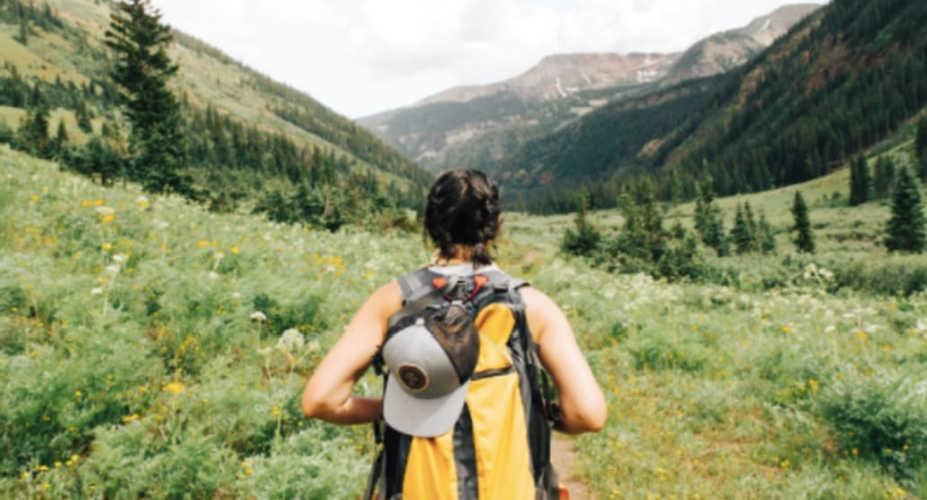
Once you get bitten by the solo-adventure bug, you won’t want to stop. Despite concern from friends and family—and the occasional fear-mongering—if you know what you’re doing and don’t push your limits alone, adventuring solo is safe, exciting, and rewarding.
Solo adventures mean the chance to move at your own pace, go farther if you feel good, or call it quits if you don’t. Traveling and adventuring on your own is also a chance to relax without worry about anyone else. The sense of accomplishment that comes with stepping outside of your comfort zone is huge for personal growth and experience.
There is freedom that comes with adventuring on your own, but oftentimes women are warned against it. While much of this is unfounded, there are a few things to keep in mind when you head out solo. Many of these are not just for women—they’re good ideas for anyone venturing into the backcountry solo.
New at Solo Adventuring? Start Small.
Sometimes the greatest adventure can be your own solo time. - Maddy Baker.
Maybe you’ve never been camping alone before, or hiked longer than 10 miles by yourself. Perhaps you’ve never ridden a certain bike route solo, or bagged a major peak on your own. If this is a new realm for you, don’t push it at first. Consider heading somewhere you’ve been before, and keeping it adventure low key. You can aim for a popular lake or trail, and be confident knowing other folks will be out there too.
The experience can be about the solo trip—you don’t need to have an epic adventure on top of it. Try car camping at first to see how you feel. Then you can start expanding your reach. Bring a bike and make it a two-for-one. Start by hiking to an alpine lake and camping, then hiking out on the same trail. If that feels comfortable, make it a loop next time. There’s no competition and sometimes the greatest adventure can be your own solo time.
Tell Someone Where You’re Going
Telling someone where you’re going is always a good idea, even if you’re with a partner or a group. Having someone at home (and in service) who knows where you’re going and when you plan to be back is an additional safety net. In the off chance you need help, having searchers who know where to start can also save precious time. Tell someone your trailhead, route, and expected timeline. Then be sure to follow up when you get home, letting them know you’re safe.
Have a Reliable Method of Communication
Modern backcountry communication technology is incredible. With few exceptions, you can get a message out from just about anywhere. There are a variety of options for satellite-enabled communicators on the market, which can connect to your phone for messaging (even if you don’t have service), or on the device itself. The Somewear Global Hotspot has satellite messaging, as does the Garmin inReach. SPOT is another popular choice with a variety of models to choose from.
These devices allow you to send your location to contacts, communicate via text from deep in the backcountry, and even call for help by activating an SOS button in the most dire of circumstances. It’s absolutely worth investing in one of these devices. They cost a few hundred bucks up front, and some have a monthly usage fee based on the package. The peace of mind for yourself, friends, and family is totally worth it.
Carry Primary Navigation and Backup Navigation
Before heading into the backcountry, know how to know where you’re going. - Holly Mandarich
This is another good idea for men, women, partners, and groups. Every time you travel or head into the backcountry, you should have some sort of navigation, even if you know where you’re going. This can be in the form of maps, directions, navigation apps, or a backcountry GPS device. If you’re unfamiliar with the trail, terrain, or route, backup navigation is a good idea as well. We’ve all heard stories of the fallacies of technology, and you don’t want to be solely reliant on battery-operated navigation, only to have it die on you. It’s not enough just to carry these with you—make sure you know how to read the map and use the app. Taking a course or watching refresher videos isn’t a bad idea, and be aware that some navigation apps will drain your phone battery faster than you think.
Stick to Your Limits
When you head out on a solo adventure, you rely entirely on yourself to make it back safely. Solo adventuring is not the time to drop whitewater for the first time or explore uncertain backcountry ski terrain. Sketchy situations, getting lost, or winding up in unsafe conditions is made exponentially more dangerous when you are alone. Avoid technical trails or places that would be hard to reach should you need help. Sticking to your limits is a good way to help yourself stay safe.
Get Excited About the Benefits of Solo Adventure
Don’t forget to stop, look around, and appreciate where you are and how you got there. - Holly Mandarich.
Once you get over the initial anxiety behind adventuring on your own, the freedom, confidence-boost, and flexibility might make this your favorite way to explore. When you realize you don’t have to rely on other people’s schedules, boundless possibilities open up.
Above all, don’t let the fear-mongering get to you—most of it is unfounded. Mentality is huge with solo adventuring. If you’re familiar with a trail, a section of wilderness, or a route, doing it by yourself is a natural next step. Stay within your adventure comfort zone at first, and don’t forget to stop, look around, and appreciate where you are and how you got there.
Written by Maggie Slepian for Matcha in partnership with Superfeet.




